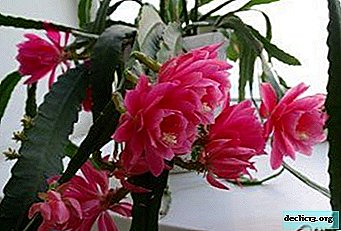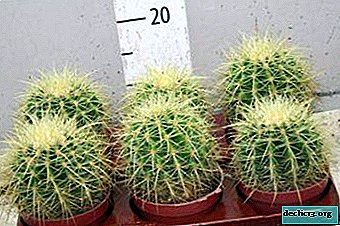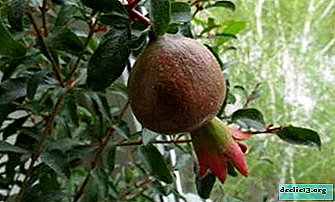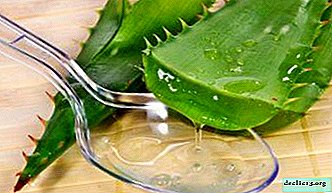Features of the content of epiphyllum at home. Rules of care and photo plants
 Epiphyllum - a completely unpretentious and beautiful flower, refers to leafy forest cacti. It is especially beautiful during flowering and is one of the most popular indoor plants and is a wonderful and durable decoration for any interior, garden or veranda.
Epiphyllum - a completely unpretentious and beautiful flower, refers to leafy forest cacti. It is especially beautiful during flowering and is one of the most popular indoor plants and is a wonderful and durable decoration for any interior, garden or veranda.
Despite its simplicity, there are still some conditions for caring for a beautiful plant, and they will be discussed in this article. For suitable living conditions, the plant will thank you with abundant flowering.
Botanical description: what kind of houseplant is this?
Epiphyllum (lat. Epiphyllum) - leaf-shaped or leaf-stem cactus, genus epiphytic. He, like all cacti, is a succulent plant, that is, he knows how to store moisture in leaves and stems.
This plant was discovered by Adrian Haworth. In 1812, the scientist described a new type of semi-shrub plant with flowers on the leaves. Hence the name, which has Greek roots and translates "on the leaves."
Much later it turned out that the epiphyllum has no leaves, but the name accurately characterizes the structure of the stem. They are long, often flat, but can be trihedral with wavy edges. The stem is very similar to a leaf and the flowers growing on the stems grow, as it were, "on the leaves."
Also, many aerial roots grow on them, which absorb moisture from the air. A significant difference from desert cacti is the absence of thorns. The epiphilum blooms in spring and blooms all summer, with large, funnel-shaped flowers. The flowers of the plant are mainly white with a pleasant aroma.
It is interesting! Epiphyllum prefers tropical and subtropical forests of Mexico, as well as Central and South America. They grow in the shade of trees or in crevices of stones. Therefore, it is called forest or phylloctactus.Description and photos of the main types and varieties
In nature, there are about 20 species of epiphyllum. Natural plants differ in that they bloom exclusively at night and in white flowers. Breeders use these species to create luxurious hybrids.
The main characteristic of varietal plants is brightly colored flowers. There are many colors: white, orange, yellow, purple, pink. Varieties with two and three-color flowers, as well as with an excellent gradient of several tones of the same color, are bred.
One of the most popular species is Epiphyllum Anguliger (Epiphyllum Anguliger lat.) Angular. Bushy plant with lignified, highly branching stems. Their length can reach 1 m and a width of 4 to 8 cm. The lateral stems are carved along the edge and similar in shape to a saw. Flowers are the main advantage of this species. They are large in size from 10 to 20 cm. Very fragrant with a delicate pleasant aroma.





Care Rules
It is worth remembering that the epiphyllum, although a cactus, is but a plant of the rainforest. It does not tolerate direct sunlight and needs evenly scattered light. The best place for him will be the windowsill on the east or west side.
Phylloctactus clearly shows two life phases: active and dormant. In the active phase, the plant stays from February to September. The optimum air temperature during this period should be 22-25 degrees. At this time, the epiphyllum needs moderate watering and regular spraying. Also for vegetation, fertilizing and fertilizing are good.
Important! An important role in the formation of the bush is played by pruning. Be sure to cut off damaged or underdeveloped branches, as well as curved or growing inside the bush.For abundant growth and flowering, the plant needs a good rest, so from October to January the flower goes into hibernation. During this period, it is better to place it in a cool place with an air temperature of 12-16 degrees and periodically water it. In more detail about what care for epiphyllum is required at home and in the flowerbed, we talked in another article.
Forest cactus propagation
Phylloctactus reproduction occurs in three ways:
- dividing the bush;
- cuttings;
- seeds.
- Bush division carried out during transplantation.
- The bush is divided in such a way that in each part there are strong and healthy roots.
- The divided parts are treated with fungicide, all rotted or dry areas are cut off.
- Then the parts are planted in pots.
- Cuttings The easiest and most common way. It is carried out in the spring before the flowering period.
- For the cuttings, a young, healthy stem is selected, from which a part of 10-15 cm is cut off.
- Then it must be dried by putting it in a cool, dry place for a couple of days.
- Dried stalks are planted in the ground for rooting.
- The plant takes root in the shade, watering begins on the third day after planting.
- Propagation by seed. After flowering, the plant has fruits, it can take several months to ripen. A ripened fetus has small, black seeds. Seeds germinate in a special substrate for succulents, under a film at an air temperature of 20-23 degrees.
Bloom
Epiphyllum bloom occurs when a comfortable environment is created for the plant. For long and lush flowering, it should have enough moisture, proper lighting and the feeding regimen. Be sure to observe the temperature regime during rest. When the flower enters the phase of active growth, when it lays the buds, you can not rearrange or rotate the pot, otherwise the plant will get rid of the buds. Also during the flowering period, phyllocactus needs abundant watering.
Diseases and Pests
 Epipimulla pests are sucking insects that are attracted to the juicy, fleshy stem of the plant. Powdery worms, scale insects, aphids, spider mites - these are the main enemies of the flower.
Epipimulla pests are sucking insects that are attracted to the juicy, fleshy stem of the plant. Powdery worms, scale insects, aphids, spider mites - these are the main enemies of the flower.
To cure a plant, you first need to remove the pests. To do this, wipe the stems with a soapy solution. Next, treat with an insecticide. The procedure is repeated every week until the complete destruction of insects. Epifimullus disease is a consequence of improper care. Most often found:
- Black rot. Shiny, black spots covering the stems. It is necessary to cut out the affected areas and spray the plant with Fundazole solution.
- Fusarium The color of the stems changes, they turn red or brown. This is due to rotting of the root. Transplantation to another substrate will save. In this case, damaged roots should be cut out and treated with ash.
- Rust. Red spots on the surface of the stems. It can be sunburn or excessive watering at low air temperatures. Treated with a solution of Topaz.
Similar plants
- Adenium It belongs to the genus of wood succulents. A stunning tree with many small, pink flowers. It grows in height to 2.5 m. It has gained wide popularity due to its beautiful flowering and easy care.
- Hatiola. Another name is Ripsalidopsis. Representative of the tropical flora of Brazil. It belongs to the genus of lithophytic cacti. Hachior has absolutely no leaves, but it consists of cylindrical or flat segments. Blooms in yellow, pink or red flowers that appear at the ends of young shoots. Completely unpretentious in leaving.
- Stapelia. Very similar to a cactus, but belongs to the genus succulent. Trihedral stems with notches grow from 10 to 60 centimeters in height. It blooms with bright, large flowers of an unusual shape. Flowers - stars of yellow, burgundy or spotty color.
- Agave. A plant with fleshy, large leaves in the form of a rosette. Blooms very rarely in the year 6-15. Peduncle with a large number of flowers grows up to 12 meters tall. After flowering, the plant may die.
You can’t help falling in love with epiphyllium. He conquers with chic colors and unpretentious care. This flowering plant will be a wonderful decoration for any windowsill.
Useful video
A visual video on the care of the epiphyllum is attached:

















